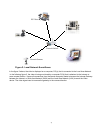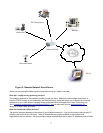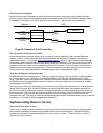
Background to the Technology
Types of Surveillance Systems
In discussing video surveillance systems there are three types to consider;
– Direct Surveillance
– Local Network Surveillance
– Remote Network Surveillance
Direct Surveillance Systems display the video images on a monitor or PC-system screen without using a data
network, as shown in the following figure. Only the cameras connected to the monitor or the PC-system can be
viewed on their respective systems;
Figure 1: Direct Surveillance Systems
Network Surveillance systems use a data network to connect to the video devices, so that the video signals can
be accessed using a digital data protocol across the network. To do this the devices need to be designed for
Internet Protocol (IP) networking.
What is the difference between Local and Remote Network Surveillance?
If you wish to view the video images from any of the network-enabled video devices using a viewer application or
web browser that is connected to the Local Area Network(LAN), such as the PC(a) in the figure below, then this
is considered local network surveillance. In this case the video signals never reach the Internet and there is no
special setup required. If you wish to view the video from a network location not directly connected to the LAN
you must go through the Internet. This is considered remote network surveillance and remote access
configuration is required. The two figures below illustrate the differences between these.
3
Monitor
PC Video System












